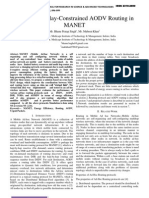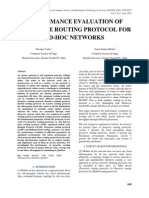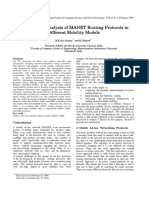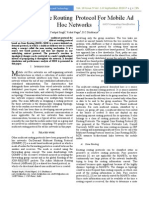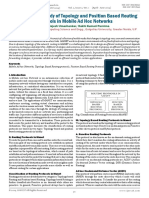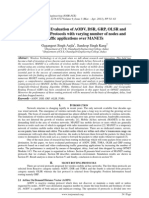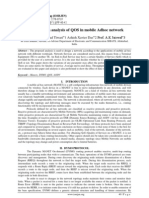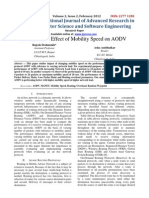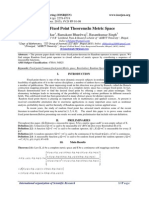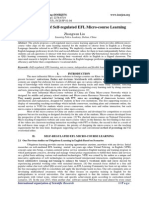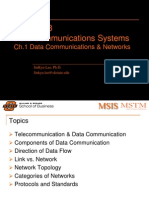Performance Study of Dymo On Demand Protocol Using Qualnet 5.0 Simulator
Performance Study of Dymo On Demand Protocol Using Qualnet 5.0 Simulator
Copyright:
Available Formats
Performance Study of Dymo On Demand Protocol Using Qualnet 5.0 Simulator
Performance Study of Dymo On Demand Protocol Using Qualnet 5.0 Simulator
Original Title
Copyright
Available Formats
Share this document
Did you find this document useful?
Is this content inappropriate?
Copyright:
Available Formats
Performance Study of Dymo On Demand Protocol Using Qualnet 5.0 Simulator
Performance Study of Dymo On Demand Protocol Using Qualnet 5.0 Simulator
Copyright:
Available Formats
IOSR Journal of Engineering (IOSRJEN) ISSN: 2250-3021 Volume 2, Issue 8 (August 2012), PP 20-24 www.iosrjen.
org
Performance Study of Dymo on Demand Protocol using Qualnet 5.0 Simulator
1
1
Mrs. C.Chandralekha, 2Balachandar. R,
Associate Professor, Dept. of MCA, SNS College of Technology, Coimbatore. 2 III MCA, SNS College of Technology, Coimbatore.
Abstract: - Wireless adhoc network support rapid on demand and adaptive communication among the nodes
due to their self configurable and autonomous nature and lack of fixed infrastructure. Since adhoc network rely on the collaboration principle the issue of key distribution and effective group by management in such networks represents two of the most important problem. This paper explore in depth the requirements of this set of applications scenarios and purposes from machine learning based on demand routing paradign.Its primary benefits are flexibility to optimize routing over a variety of property such as route length easy recovery after node failure and native support for sink mobility . As efficient approach to its consider routing algorithm in which network connectivity is determined in the process of establishing routes. The shortest path from source to designation in a static network is optimal route this idea is not easily extended to Manet.Factors such as power expended, variable wireless link quality, propagation, Pathless, fading, multiuser interference and topological changes become relevant use. Performance is an interesting issue for different protocols. Routing In adhoc networks is challenging due to mobility of nodes. Dynamic adhoc on demand routing protocols is one in which is intended for the use by mobile nodes in wireless adhoc multihop adhoc network. It can adopt changing network topology and determine unicast routes between nodes within the network. Mobile Adhoc network has evolved fast in the last 10 year into standard in the communication world. Manet is self configuring network of mobile node connected by wireless links to form an arbitrary topology without the use of existing infrastructure. In this paper we deal with new implementation of routing protocol dynamic manet on demand, It offer adaptation to charge the network topology and determine unicast router between nodes within the network on demand. Our goal is to carry out a systematic performance study of on demand dynamic routing protocols (DYMO) which initiate routing activities on demand basis. High routing load .Performance analyzed using network simulator qualnet 5.0. It mobility network size and load is analyzed. We make recommendation about how the performance how to improved. Keywords: - Adhoc networks. On demand network, ADOV, DYMO, DSR, QUALNET1.
I.
INTRODUCTION:
Manets were traditionally developed for networks; A manet is a dynamic Wireless network wireless network with or without fixed infrastructure. Nodes may move freely and organize themselves, arbitrarily thus the network topology may charge rapidly and unpredictably .Each node may communicate directly with any node. Communication beyond that range is achieved by using intermediate nodes to relay messages hop by hop such a route may include multiple hops and such a route may include multiple hops and therefore routing network may be a multihop network. Manet donot depend on centralized administration rather than each node acts as an independent router and typically also as an application node generating and receiving application data. The routing protocols have unique protocols with their unique characteristics. .Hence in order to find out the most adaptive and efficient routing protocol for the highly dynamic topology in Adhocnetwork , the routing protocols behavior has to be analyzed and using varied node mobility , speed traffic and network size.
II.
MOBILE ADHOC NETWORKING PROTOCOLS:
The main problem with adhoc network is how to send a message from one node to another with no direct link. The nodes are moving around unpredictable and it is very challenging, which nodes that are directly linked together, The Topology of an Adhoc network is constantly changing and it is very difficult for routing process. Manet doesnt depend on centralized administration rather each node acts as an independent router and typically also an application node. Routing protocols can be divided into the following categories 1. Unicast routing protocols 2. Topology based routing protocol o Proactive routing o Reactive routing o Hybrid routing 3. Multicast routing protocol
www.iosrjen.org
20 | P a g e
Performance Study of Dymo on Demand Protocol using Qualnet 5.0 Simulator
4. Broadcast routing algorithm
Manet routing protocols can be classified into two main categories proactive routing can be classified into two main categories proactive routing protocol attempt to maintain routing information .For every pair of network nodes by actively propagating route updates. Reactive protocols establish a route to a destination only when needed .The source node imitate a router discovery process when the root is required and once a router has been established .It is maintained until each destination only when needed .The source node initiates a router discovery process when the root is required and once a router has been established. It is maintained until each destination becomes accessible or until the router is no longer used. As reactive routing protocol flood the network to discover the route, they are not optimal in terms of bandwidth utilization but they scale well in the frequency of topology change. it can Be classified into the categories source routing and hop by hop routing. Source routing: in source routing on demand protocols each data packets carry complete source to destination address. Each intermediate node forwards these packets according to the information kept in the header of each packet .so the intermediate nodes does not need up to date routing information . For each active route in order to forward the packet towards the destination . HOP BY HOP Each data occur by coding routing request packets through packets only carry the destination address and next hop address so that each intermediate node in path to destination uses its routing table to forward each data packet towards the destination uses its routing table to forward each data packet towards the destination, There are three on demand routing protocols 1. Adhoc on demand routing 2. Dynamic source routing 3. Dynamic Manet on demand routing protocol
III.
ON DEMAND ROUTING PROTOCOLS
These protocols take a lazy approach to routing .When a source want to send to a designation ,It invokes the route discovery mechanisms to find the path to the desination.The route remains valid till the destination is reachable or until the route is no longer needed. Unlike, Table driven, reactive or on demand routing protocols do not main an updated table. An important feature of AODV is the maintenance of timer based states in each node, regarding utilization of individual routing table entries. A routing table is expired if not used recently A set of predecessor is maintained for each routing Table entry. The benefits of AODV are that it favours the least congested route instead of the shortest route and it supports path unicast and multicast packet transmission even for the nodes in constant movement. AODV does not put any additional overhead on data packets as it does not make use of source routing so valid is expired and the determination of a reasonable expiry time is difficult .When network grows performance metrics began to decrease..TORA is an adaptive and efficient routing algorithm primarily designed for mobile adhoc Networks. Main features are propagated to control message only around the points of failures when a link failure occurs. TORA is scale up a large networks but has higher overhead to smaller Network Routes are adopted according to topological change Route is erased on reception of CLR packets. TORA faces a severe security problem. AODV can gather only limited amount of routing information. DSR and AODV are the only two competing reactive routing protocols Both of them consists of route discovery and route maintenance models. The Dynamic MANET On-demand (DYMO) routing protocol enables reactive, multihop unicast routing between participating DYMO routers. The basic operations of the DYMO protocol are route discovery and route maintenance.
IV.
DYMO
Dynamic Manet on demand routing protocol is the fast routing protocol. It discovers the uncast routes among DYMO routers within the network in on demand fashion, offering improved converge in dynamic topology. 1) Route discovery: When a source needs to send a data packet, it sends an RREQ to discover the route to the particular destination. After issuing an RREQ the or gin DYMO router waits for a route to be discovered. If the route is not obtained it si Waited and waiting time is calculated .Data Packets awaiting a route should be buffered by the source router . This buffer should have a fixed limited size.
www.iosrjen.org
21 | P a g e
Performance Study of Dymo on Demand Protocol using Qualnet 5.0 Simulator
2) Route maintenance It consists of two operations. In order to preserve routes in use, DYMO routers extend route lifetimes upon successfully forwarding a packet. In order to react to changes in the network topology, DYMO routers monitor links over which traffic is flowing. When a data packet is received for forwarding and a route for the destination is not known or the route is broken, then the DYMO router of source of the packet is notified. A Route Error (RERR) is sent toward the packet source to indicate the current route to a particular destination is invalid or missing. When the source's DYMO router receives the RERR, it deletes the route. If the source's DYMO router later receives a packet for forwarding to the same destination, it will need to perform route discovery again for that destination. DYMO uses sequence numbers to ensure loop freedom [Perkins99]. Sequence numbers enable DYMO routers to determine the order of DYMO route discovery messages, thereby avoiding use of stale routing information. Comparison between on demand routing protocols DSR YES NO Route cache Source router Yes Send rerr ,packet Salvage choose another route No AODV NO HELLO messages Route table Sequence number No Send RERR route Rediscovery DYMO NO Messages will come Route Table Sequence number Yes Send RERR Re route discovery
SOURCE ROUTE NEIGHBOUR DIRECTION Route storage Loop freedom maintenance Multipath Route Maintenance
Multicast capability
Yes
Yes
V.
SIMULATION SETUP
The qualnet 5.0 network simulator is used for analysis. In the scenario the ftp connection is used as a MAC layer, Here we study the performance of dynamic nature of communication network. Simulation is wireless and FTP algorithms are used. in this scenario we sue 1500m*1500m orgin.The mobility model used here is random waypoint in the rectangular field. The multiple nodes are applied and destination nodes are attached. Simulation parameter parameter Value Area 1500m*1500m Simulation Time 91,120,200 sec 2.4 ghz Channel frequency Data rate 2 Mhz Path loss model Two way model Mobility model Random way point Packet size 512 bytes Mac protocol Ieee 802.1
VI.
MOBILITY MODEL:
Random way point is used which means a message is sent from source to destination by step by step and it have little delay in each node and then it travel from one node to other node .
www.iosrjen.org
22 | P a g e
Performance Study of Dymo on Demand Protocol using Qualnet 5.0 Simulator
Random model scenerio VII. PERFORMANCE METRICS The following four important performance metrics are considered for evaluation of these on demand routing parameter Packet delivery fraction: The ratio of the data packets delivered to the destination to those generated by the CBR sources Average end to end delay of data packets: This includes all possible delays caused by buffering during route discovery latency,queing at the interface queue retransmission delay rate at the MAC ,end propagation
Throughput: it is average rate of successful data packets received at destination. It is usually measured by bits per second End to end delay: A special packet is sent from source and destination and calculates the difference between the send time and receive time.
www.iosrjen.org
23 | P a g e
Performance Study of Dymo on Demand Protocol using Qualnet 5.0 Simulator VIII. CONCLUSION
This paper provides explanation anlaysis of ondemand routing protocols DYMO using qualnet5.0. It has also performed a comparision among the performance metrits like pause time,throughput,jitter and end to end delay.There are various simulators for measuring the protoocls ,here we use the new version of qualnet5.o for Dymo protocol. Graphs and simulation can show the performance the DYMO enhanced version of AODV . Dymo will perform better than some protocols.The effect of increasing nodes was also analyzed easily by the qualnet5.o.Hence the performance of the DYMO is better than ADOV and\DSR.From the result of our studies and analysis it can be concluded that , on an average DYMO Iis better than AODV and DSR. The work done in this research aims to develop an understanding of the effects of mobility patterns on routing performance. In future, we intend to study mobility models to determine the MANET protocol best suited to military mobile adhoc networks.
REFERENCES:
[1] [2] [3] [4] [4] [5] [6] Scalable Network Technology, QualNet5.0 simulator tutorial and QualNet um,http://www.scalablenetworks.com/foru ms Aisha Hassan Abdulla, A Simulation Based Performance Analysis of Reactive Routing Protocols in Wireless Mesh Networks, 2009 IEEE DOI 10.1109/ICFN.2009 PERKINS, C,. BELDING ROYER, E, S. Das: Ad hoc On Demand Distance Vector (AODV) Routing, frp://ftp.isi.edu/innotes/rfc3561.txt Stefano. B,. et. al., "Mobile ad hoc Networking", IEEEPress, July 2004. Chakeres I, et. al., "Dynamic MANET On-demand (DYMO) Routing", IETF, June 2006 Marco Fiore code - Webpage, http://www.tlcnetworks. polito.it/fiore/,Accessed on September 2007. Arun Kumar B. R., Lokanatha C. Reddy, Prakash S. Hiremath Performance Comparison of Wireless Mobile Ad-Hoc Network Routing Protocols IJCSNS International Journal of Computer Science and Network Security, VOL.8 No.6, pp. 3 C.Chandralekha is from Coimbatore . She has completed her M.C.A. Degree at Madurai Kamaraj University campus , Madurai. She was working as Lecturer at St.Josephs college of Engineering ,Jeppiaar Nagar, Chennai. Currently She is a Research scholar and Associate Professor at SNS College of Technology , Coimbatore. Her area of research is MANET
R.Balachandar is from Coimbatore born in October 16, 1990.He has completed his Under Graduation B.Sc. Degree in Computer Science from Bharathiyar University , Coimbatore. He is currently pursuing MCA degree from Anna University , Chennai. He is a Microsoft Certified IT Professional ; Oracle Certified Java Professional. His areas of interest include Network Security , Mobile computing.
www.iosrjen.org
24 | P a g e
You might also like
- Kozinets (2010) Netnography - Doing Ethnographic Research OnlineDocument228 pagesKozinets (2010) Netnography - Doing Ethnographic Research OnlineOana Cory100% (15)
- Powerpoint & PitchbooksDocument1 pagePowerpoint & Pitchbookskelvin Prince100% (2)
- Hannstar Product Specification: Model: Hsd103Kpw2 - A10 10.25" Color TFT-LCD ModuleDocument26 pagesHannstar Product Specification: Model: Hsd103Kpw2 - A10 10.25" Color TFT-LCD Modulegshock65No ratings yet
- Assign 3Document9 pagesAssign 3Yudha PP0% (1)
- Study and Analysis of Throughput, Delay and Packet Delivery Ratio in MANET For Topology Based Routing Protocols (AODV, DSR and DSDV)Document5 pagesStudy and Analysis of Throughput, Delay and Packet Delivery Ratio in MANET For Topology Based Routing Protocols (AODV, DSR and DSDV)PremKumarNo ratings yet
- IjrsatDocument4 pagesIjrsatSrikanth ShanmukeshNo ratings yet
- A Comparative Study of Broadcast Based Routing Protocols in Mobile Ad Hoc NetworksDocument6 pagesA Comparative Study of Broadcast Based Routing Protocols in Mobile Ad Hoc NetworksInternational Journal of Application or Innovation in Engineering & ManagementNo ratings yet
- Energy Efficient Routing Protocols in Mobile Ad Hoc NetworksDocument7 pagesEnergy Efficient Routing Protocols in Mobile Ad Hoc NetworksIJERDNo ratings yet
- Performance Evaluation of Proactive Routing Protocol For Ad-Hoc NetworksDocument6 pagesPerformance Evaluation of Proactive Routing Protocol For Ad-Hoc NetworksSuzaini SupingatNo ratings yet
- Analysing The Interaction Between Mobility Model and Unipath Routing Protocols in Mobile Ad Hoc NetworksDocument7 pagesAnalysing The Interaction Between Mobility Model and Unipath Routing Protocols in Mobile Ad Hoc NetworkseditorijaiemNo ratings yet
- Performance Evaluation of Energy Traffic in Ipv6 Networks: Dharam Vir S.K.Agarwal S.A.Imam3Document10 pagesPerformance Evaluation of Energy Traffic in Ipv6 Networks: Dharam Vir S.K.Agarwal S.A.Imam3International Journal of computational Engineering research (IJCER)No ratings yet
- Performance Analysis of MANET Routing Protocols in Different Mobility ModelsDocument8 pagesPerformance Analysis of MANET Routing Protocols in Different Mobility Modelsnazm basmNo ratings yet
- BN 2422362241Document6 pagesBN 2422362241IJMERNo ratings yet
- Relative Study of Multipath Extensions of AodvDocument3 pagesRelative Study of Multipath Extensions of AodvInternational Journal of Application or Innovation in Engineering & ManagementNo ratings yet
- 10 Multicast Zone Routing Protocol For Mobile Ad Hoc NetworksDocument6 pages10 Multicast Zone Routing Protocol For Mobile Ad Hoc NetworksakshusvgNo ratings yet
- Routing ToplogyyyDocument4 pagesRouting ToplogyyyjemalNo ratings yet
- Report On Glom OsimDocument16 pagesReport On Glom OsimmanishNo ratings yet
- Performance Analysis of AODV, DSR and ZRP Protocols in Vehicular Ad-Hoc Network Using QualnetDocument5 pagesPerformance Analysis of AODV, DSR and ZRP Protocols in Vehicular Ad-Hoc Network Using QualnetInternational Journal of Application or Innovation in Engineering & ManagementNo ratings yet
- A Survey On Multipath Routing Protocols For ManetsDocument4 pagesA Survey On Multipath Routing Protocols For ManetsInternational Journal of Application or Innovation in Engineering & ManagementNo ratings yet
- Proactive and On-Demand. Proactive Protocols Attempt To Maintain Up-To-Date RoutingDocument47 pagesProactive and On-Demand. Proactive Protocols Attempt To Maintain Up-To-Date RoutingRishabh SharmaNo ratings yet
- Performance Evaluation and Comparison of Aodv and AomdvDocument5 pagesPerformance Evaluation and Comparison of Aodv and AomdvBekka MahmoudiNo ratings yet
- A Step of Mobile Ad-Hoc On-Demand Routing Protocols Towards 4G Cellular NetworksDocument5 pagesA Step of Mobile Ad-Hoc On-Demand Routing Protocols Towards 4G Cellular Networksghabr2000No ratings yet
- A Comparison Study of Qos Using Different Routing Algorithms in Mobile Ad Hoc NetworksDocument4 pagesA Comparison Study of Qos Using Different Routing Algorithms in Mobile Ad Hoc NetworksEEE_ProceedingsNo ratings yet
- NS2 Report - Analysis of AODV & DSDV Routing Protocol: Muhammad SamiDocument3 pagesNS2 Report - Analysis of AODV & DSDV Routing Protocol: Muhammad SamiSamiunnNo ratings yet
- Review MANET and ChallengesDocument5 pagesReview MANET and ChallengesDịu Thư NguyễnNo ratings yet
- Performance Analysis of Reactive & Proactive Routing Protocols For Mobile Adhoc - Networks Name of First Author, Name of Second AuthorDocument7 pagesPerformance Analysis of Reactive & Proactive Routing Protocols For Mobile Adhoc - Networks Name of First Author, Name of Second Authorpiyushji125No ratings yet
- Comparative Study of Mobile Ad-Hoc Routing Algorithm With Proposed New AlgorithmDocument8 pagesComparative Study of Mobile Ad-Hoc Routing Algorithm With Proposed New AlgorithmRakeshconclaveNo ratings yet
- Performance Evaluation of Manet Routing Protocols On The Basis of TCP Traffic PatternDocument8 pagesPerformance Evaluation of Manet Routing Protocols On The Basis of TCP Traffic PatternijitcsNo ratings yet
- OLSRDocument6 pagesOLSRHanna RizqisdelightsNo ratings yet
- MANET Routing ProtocolsDocument3 pagesMANET Routing ProtocolsShagun PandeyNo ratings yet
- Performance Analysis of Mobile Adhoc Network Routing Protocols Over TCPDocument10 pagesPerformance Analysis of Mobile Adhoc Network Routing Protocols Over TCPijansjournalNo ratings yet
- Survey of Routing Protocols For Mobile Ad Hoc Networks: Ashima Batra, Abhishek Shukla, Sanjeev Thakur, Rana MajumdarDocument7 pagesSurvey of Routing Protocols For Mobile Ad Hoc Networks: Ashima Batra, Abhishek Shukla, Sanjeev Thakur, Rana MajumdarInternational Organization of Scientific Research (IOSR)No ratings yet
- Introduction of Mobile Ad Hoc Network (MANET)Document5 pagesIntroduction of Mobile Ad Hoc Network (MANET)Kartheeswari SaravananNo ratings yet
- Ijacit 6Document8 pagesIjacit 6Sushain SharmaNo ratings yet
- An Extensive Performance Analysis of CBRP, DSR and AODV Protocols For Dense and Sparse Topologies in MANETDocument11 pagesAn Extensive Performance Analysis of CBRP, DSR and AODV Protocols For Dense and Sparse Topologies in MANETIJERDNo ratings yet
- Comprehensive Evaluation of Aodv, DSR, GRP, Olsr and Tora Routing Protocols With Varying Number of Nodes and Traffic Applications Over ManetsDocument8 pagesComprehensive Evaluation of Aodv, DSR, GRP, Olsr and Tora Routing Protocols With Varying Number of Nodes and Traffic Applications Over ManetsInternational Organization of Scientific Research (IOSR)No ratings yet
- Ijaiem 2014 04 29 083Document9 pagesIjaiem 2014 04 29 083International Journal of Application or Innovation in Engineering & ManagementNo ratings yet
- Data Variation Analysis of QOS in Mobile Adhoc NetworkDocument3 pagesData Variation Analysis of QOS in Mobile Adhoc NetworkIOSRJEN : hard copy, certificates, Call for Papers 2013, publishing of journalNo ratings yet
- Performance Comparison On Trust Based Power Aware Reliable On Demand Routing Protocol in Mobile Ad Hoc NetworksDocument9 pagesPerformance Comparison On Trust Based Power Aware Reliable On Demand Routing Protocol in Mobile Ad Hoc NetworksInternational Organization of Scientific Research (IOSR)No ratings yet
- Performance Effect of Mobility Speed On AODVDocument4 pagesPerformance Effect of Mobility Speed On AODVeditor_ijarcsseNo ratings yet
- A Review On Dynamic Manet On Demand Routing Protocol in ManetsDocument6 pagesA Review On Dynamic Manet On Demand Routing Protocol in Manetswarse1No ratings yet
- Compusoft, 3 (6), 957-960 PDFDocument4 pagesCompusoft, 3 (6), 957-960 PDFIjact EditorNo ratings yet
- Performance Evaluation of Ad Hoc Routing Protocols Using ns2 SimulationsDocument18 pagesPerformance Evaluation of Ad Hoc Routing Protocols Using ns2 SimulationsSurbhi YadavNo ratings yet
- Ad HocDocument13 pagesAd HocAnthony MaritaNo ratings yet
- Routing in MANETsDocument25 pagesRouting in MANETsSubramanya Suresh GudigarNo ratings yet
- A Comprehensive Comparison of Routing Protocols For Large Scale Wireless MANETsDocument6 pagesA Comprehensive Comparison of Routing Protocols For Large Scale Wireless MANETsManoharNo ratings yet
- Module-III: CS364 - Mobile ComputingDocument72 pagesModule-III: CS364 - Mobile ComputingARUNNo ratings yet
- Simulation of Ad-Hoc Networks Using DSDV, AODV and DSR Protocols and Their Performance ComparisonDocument6 pagesSimulation of Ad-Hoc Networks Using DSDV, AODV and DSR Protocols and Their Performance ComparisonKesav RameshKumarNo ratings yet
- Manets Using Advance DSR Algorithm and Improve The Secure TransmissionDocument4 pagesManets Using Advance DSR Algorithm and Improve The Secure Transmissionsyedbin2014No ratings yet
- Performances of Ad Hoc Networks Under Deterministic and Probabilistic Channel Conditions: Cases For Single Path and Multipath Routing ProtocolsDocument21 pagesPerformances of Ad Hoc Networks Under Deterministic and Probabilistic Channel Conditions: Cases For Single Path and Multipath Routing ProtocolsAIRCC - IJCNCNo ratings yet
- Analysis of Multicast Routing Protocols: Puma and Odmrp: S Sumathy, Beegala Yuvaraj, E Sri HarshaDocument9 pagesAnalysis of Multicast Routing Protocols: Puma and Odmrp: S Sumathy, Beegala Yuvaraj, E Sri HarshaIJMERNo ratings yet
- Performance Comparison and Analysis of DSDV and AODV For MANETDocument6 pagesPerformance Comparison and Analysis of DSDV and AODV For MANETHippihippyNo ratings yet
- Multicast Operation of The Ad-Hoc On-Demand Distance Vector Routing ProtocolDocument12 pagesMulticast Operation of The Ad-Hoc On-Demand Distance Vector Routing ProtocolPinky InsaNo ratings yet
- Performance Comparison of Routing Protocols For Manets.: Anshu Bajaj, Tripti MalhotraDocument9 pagesPerformance Comparison of Routing Protocols For Manets.: Anshu Bajaj, Tripti MalhotraIOSRJEN : hard copy, certificates, Call for Papers 2013, publishing of journalNo ratings yet
- A Review and Comparison of Reliable Unicast Routing Protocols For Mobile Ad Hoc NetworksDocument11 pagesA Review and Comparison of Reliable Unicast Routing Protocols For Mobile Ad Hoc NetworksAnita SivaSubramanianNo ratings yet
- Evaluation of Various Traffic Loads in MANET With DSR Routing Protocol Through Use of OPNET SimulatorDocument9 pagesEvaluation of Various Traffic Loads in MANET With DSR Routing Protocol Through Use of OPNET SimulatorijdpsNo ratings yet
- Imran2016 PDFDocument5 pagesImran2016 PDFNader JalalNo ratings yet
- Ijettcs 2013 08 11 079Document8 pagesIjettcs 2013 08 11 079International Journal of Application or Innovation in Engineering & ManagementNo ratings yet
- Adhoc Wireless Sensor Network Unit 1 PART A and PART B Questions and AnswersDocument21 pagesAdhoc Wireless Sensor Network Unit 1 PART A and PART B Questions and Answerssusan williamNo ratings yet
- Performance Comparison of AODV, DSDV, OLSR and DSR Routing Protocols in Mobile Ad Hoc NetworksDocument4 pagesPerformance Comparison of AODV, DSDV, OLSR and DSR Routing Protocols in Mobile Ad Hoc Networksezhar saveroNo ratings yet
- Adhoc Final Assignment For SubmissionDocument6 pagesAdhoc Final Assignment For SubmissionMulatu TadeleNo ratings yet
- Simulation and Analysis of AODV and AOMDV Protocol During Link Breakage in MANET Using NS-2Document6 pagesSimulation and Analysis of AODV and AOMDV Protocol During Link Breakage in MANET Using NS-2Zele WondeNo ratings yet
- A Timing Analysis of Aodv: Abstract. Mobile Ad Hoc Networks (Manets) Are Wireless NetworksDocument16 pagesA Timing Analysis of Aodv: Abstract. Mobile Ad Hoc Networks (Manets) Are Wireless NetworkslyxnicolasNo ratings yet
- Application of The Multi-Curve Reconstruction Technology in Seismic InversionDocument4 pagesApplication of The Multi-Curve Reconstruction Technology in Seismic InversionIOSRJEN : hard copy, certificates, Call for Papers 2013, publishing of journalNo ratings yet
- MMSE Adaptive Receiver vs. Rake Receiver Performance Evaluation For UWB Signals Over Multipath Fading ChannelDocument13 pagesMMSE Adaptive Receiver vs. Rake Receiver Performance Evaluation For UWB Signals Over Multipath Fading ChannelIOSRJEN : hard copy, certificates, Call for Papers 2013, publishing of journalNo ratings yet
- The Identification of Lithologic Traps in Nanpu Sag D3 Member of Gaonan RegionDocument5 pagesThe Identification of Lithologic Traps in Nanpu Sag D3 Member of Gaonan RegionIOSRJEN : hard copy, certificates, Call for Papers 2013, publishing of journalNo ratings yet
- Random Fixed Point Theoremsin Metric Space: Balaji R Wadkar, Ramakant Bhardwaj, Basantkumar SinghDocument9 pagesRandom Fixed Point Theoremsin Metric Space: Balaji R Wadkar, Ramakant Bhardwaj, Basantkumar SinghIOSRJEN : hard copy, certificates, Call for Papers 2013, publishing of journalNo ratings yet
- Study On Logging Interpretation Model and Its Application For Gaotaizi Reservoir of L OilfieldDocument6 pagesStudy On Logging Interpretation Model and Its Application For Gaotaizi Reservoir of L OilfieldIOSRJEN : hard copy, certificates, Call for Papers 2013, publishing of journalNo ratings yet
- The Experimental Study On The Compatibility Relationship of Polymer and Oil LayerDocument5 pagesThe Experimental Study On The Compatibility Relationship of Polymer and Oil LayerIOSRJEN : hard copy, certificates, Call for Papers 2013, publishing of journalNo ratings yet
- Effectiveness in Addressing The Sustainability and Environmental Issue Involving Use of Coal Ash As Partial Replacement of Cement in ConcreteDocument6 pagesEffectiveness in Addressing The Sustainability and Environmental Issue Involving Use of Coal Ash As Partial Replacement of Cement in ConcreteIOSRJEN : hard copy, certificates, Call for Papers 2013, publishing of journalNo ratings yet
- Introduction To Accounting Professional Judgment ManipulationDocument3 pagesIntroduction To Accounting Professional Judgment ManipulationIOSRJEN : hard copy, certificates, Call for Papers 2013, publishing of journalNo ratings yet
- Constructions Quality Versus Bad Components in Jordanian CementDocument3 pagesConstructions Quality Versus Bad Components in Jordanian CementIOSRJEN : hard copy, certificates, Call for Papers 2013, publishing of journalNo ratings yet
- Strength Properties of Commercially Produced Clay Bricks in Six Different Locations/ States in NigeriaDocument10 pagesStrength Properties of Commercially Produced Clay Bricks in Six Different Locations/ States in NigeriaIOSRJEN : hard copy, certificates, Call for Papers 2013, publishing of journalNo ratings yet
- "Sign Language Translator": Mr. Sangam Mhatre, Mrs. Siuli DasDocument4 pages"Sign Language Translator": Mr. Sangam Mhatre, Mrs. Siuli DasIOSRJEN : hard copy, certificates, Call for Papers 2013, publishing of journalNo ratings yet
- Validating The Theories of Urban Crime in The City of RaipurDocument10 pagesValidating The Theories of Urban Crime in The City of RaipurIOSRJEN : hard copy, certificates, Call for Papers 2013, publishing of journalNo ratings yet
- Modeling and Design of Hybrid Power Plants: Ahmed KH A. E. AlkhezimDocument5 pagesModeling and Design of Hybrid Power Plants: Ahmed KH A. E. AlkhezimIOSRJEN : hard copy, certificates, Call for Papers 2013, publishing of journalNo ratings yet
- Construction of Self-Regulated EFL Micro-Course Learning: Zhongwen LiuDocument4 pagesConstruction of Self-Regulated EFL Micro-Course Learning: Zhongwen LiuIOSRJEN : hard copy, certificates, Call for Papers 2013, publishing of journalNo ratings yet
- Assessment of The Life Quality of Urban Areas Residents (The Case Study of The City of Fahraj)Document6 pagesAssessment of The Life Quality of Urban Areas Residents (The Case Study of The City of Fahraj)IOSRJEN : hard copy, certificates, Call for Papers 2013, publishing of journalNo ratings yet
- The Research of Source System On Chang 6 Sand Formation in Ansai OilfieldDocument5 pagesThe Research of Source System On Chang 6 Sand Formation in Ansai OilfieldIOSRJEN : hard copy, certificates, Call for Papers 2013, publishing of journalNo ratings yet
- Classification of Fault Condensed Belt and Faults Development Characteristics in Xingbei Region, Daqing PlacanticlineDocument5 pagesClassification of Fault Condensed Belt and Faults Development Characteristics in Xingbei Region, Daqing PlacanticlineIOSRJEN : hard copy, certificates, Call for Papers 2013, publishing of journalNo ratings yet
- Yingtai Area in Songliao Basin As The Main Layer Tight Oil "Dessert" Reservoir PredictionDocument4 pagesYingtai Area in Songliao Basin As The Main Layer Tight Oil "Dessert" Reservoir PredictionIOSRJEN : hard copy, certificates, Call for Papers 2013, publishing of journalNo ratings yet
- Analysis of Distribution and Effection of Oil-Water: Yue FeiDocument6 pagesAnalysis of Distribution and Effection of Oil-Water: Yue FeiIOSRJEN : hard copy, certificates, Call for Papers 2013, publishing of journalNo ratings yet
- Oil and Water Layer Identification by Dual-Frequency Resistivity LoggingDocument4 pagesOil and Water Layer Identification by Dual-Frequency Resistivity LoggingIOSRJEN : hard copy, certificates, Call for Papers 2013, publishing of journalNo ratings yet
- Detecting Spammers in Youtube: A Study To Find Spam Content in A Video PlatformDocument5 pagesDetecting Spammers in Youtube: A Study To Find Spam Content in A Video PlatformIOSRJEN : hard copy, certificates, Call for Papers 2013, publishing of journalNo ratings yet
- Application of Cloud Transformation Technology in Predicting Reservoir PropertyDocument4 pagesApplication of Cloud Transformation Technology in Predicting Reservoir PropertyIOSRJEN : hard copy, certificates, Call for Papers 2013, publishing of journalNo ratings yet
- Genetic Analysis of Low Resistivity Reservoir: Gang Wang, Kai Shao, Yuxi CuiDocument3 pagesGenetic Analysis of Low Resistivity Reservoir: Gang Wang, Kai Shao, Yuxi CuiIOSRJEN : hard copy, certificates, Call for Papers 2013, publishing of journalNo ratings yet
- Bose-Einstein Condensation Controlled by (HOP+OLP) Trapping PotentialsDocument5 pagesBose-Einstein Condensation Controlled by (HOP+OLP) Trapping PotentialsIOSRJEN : hard copy, certificates, Call for Papers 2013, publishing of journalNo ratings yet
- Symbolism As A Modernist Featurein A Passage To India: Ahmad Jasim Mohammad, Suhairsaad Al-DeenDocument4 pagesSymbolism As A Modernist Featurein A Passage To India: Ahmad Jasim Mohammad, Suhairsaad Al-DeenIOSRJEN : hard copy, certificates, Call for Papers 2013, publishing of journalNo ratings yet
- Characteristic of Cracks in Tight Sandstone Reservoir: Ming Yan Yunfeng Zhang Jie Gao Ji GaoDocument4 pagesCharacteristic of Cracks in Tight Sandstone Reservoir: Ming Yan Yunfeng Zhang Jie Gao Ji GaoIOSRJEN : hard copy, certificates, Call for Papers 2013, publishing of journalNo ratings yet
- Unit - IDocument55 pagesUnit - IsaravanasasikumarNo ratings yet
- My Chemical Romance-Im Not OkayDocument14 pagesMy Chemical Romance-Im Not OkayAlvin Alan TalampasNo ratings yet
- 361 Project CodeDocument10 pages361 Project CodeskdlfNo ratings yet
- Design QualityDocument32 pagesDesign QualityLibanos FekaduNo ratings yet
- Interview CE CSE IT 12.02.2021Document23 pagesInterview CE CSE IT 12.02.2021Butchi MurtyNo ratings yet
- Prediction of Diabetic Patient Readmission Using Machine LearningDocument4 pagesPrediction of Diabetic Patient Readmission Using Machine LearningSanjana PolNo ratings yet
- 1 Oracle Developer Data Types Essentials m1 SlidesDocument70 pages1 Oracle Developer Data Types Essentials m1 SlidesAnitha RaniNo ratings yet
- MSIS4523 Ch1.Intro To DatacomDocument31 pagesMSIS4523 Ch1.Intro To DatacomAlicia Kay LearNo ratings yet
- BLWPDocument13 pagesBLWPRonald TesoroNo ratings yet
- Samsung: HistoryDocument8 pagesSamsung: HistoryKastuv Mani TuladharNo ratings yet
- Pvtsim Technical Overview 2016 Download v3Document16 pagesPvtsim Technical Overview 2016 Download v3Jorge Vásquez CarreñoNo ratings yet
- Proofpoint Office365 Solution BriefDocument2 pagesProofpoint Office365 Solution BriefSteveNo ratings yet
- J1939 IntroductionDocument2 pagesJ1939 Introductionjrsimma0% (1)
- AIS Lecture 3Document3 pagesAIS Lecture 3Pink WorkuNo ratings yet
- Bangalore Software Companies - List of Software Companies in BangaloreDocument6 pagesBangalore Software Companies - List of Software Companies in Bangalorechhote999No ratings yet
- #Include #Include #Include Void Main (Document47 pages#Include #Include #Include Void Main (ChfNo ratings yet
- CC AmplifierDocument3 pagesCC AmplifierHarsha100% (2)
- Navigating Microsoft Operations FrameworkDocument3 pagesNavigating Microsoft Operations FrameworkJohann NeethlingNo ratings yet
- DEMP Question BankDocument2 pagesDEMP Question Bankrajgorge4No ratings yet
- Market Cloud - IT Capabilities Deck-V1Document30 pagesMarket Cloud - IT Capabilities Deck-V1pricelessindianNo ratings yet
- Issues in Managing Text in Lotes, & An Introduction To PowerpointDocument34 pagesIssues in Managing Text in Lotes, & An Introduction To PowerpointPersonNo ratings yet
- PROPER Version 8.00: NotesDocument180 pagesPROPER Version 8.00: NotesAlfredo DottaviNo ratings yet
- Synergy Techdata 12810133280 - 1Document12 pagesSynergy Techdata 12810133280 - 1Jorio LemosNo ratings yet
- Skanti Scansat f77 Operators ManualDocument132 pagesSkanti Scansat f77 Operators ManualborisgolodenkoNo ratings yet
- Apuntes - Dme Interface 1.5Document147 pagesApuntes - Dme Interface 1.5CarlosQuelartNo ratings yet
- Traders Checklist PDFDocument17 pagesTraders Checklist PDFJay Sagar0% (1)





